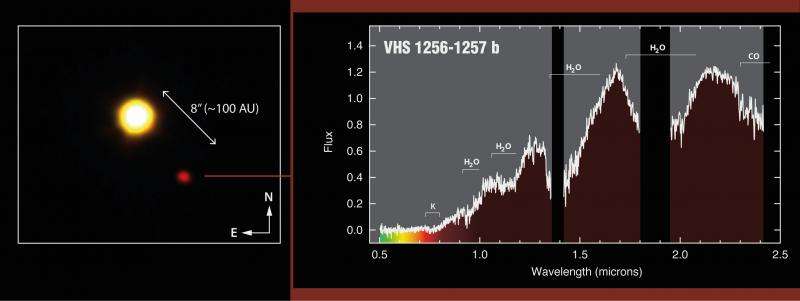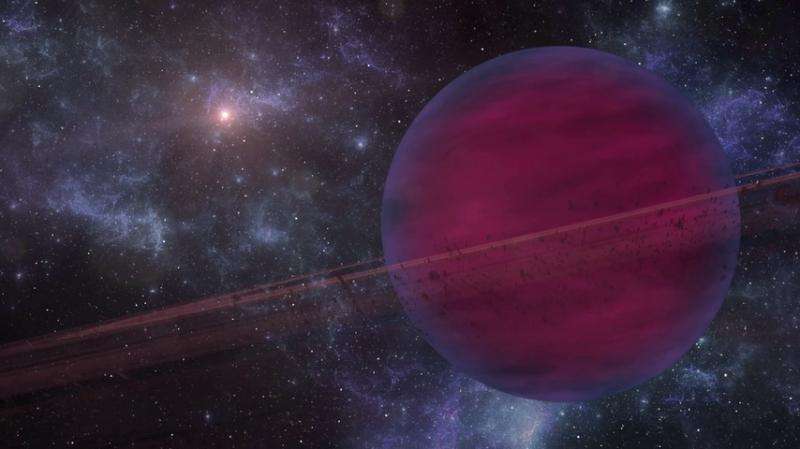Researchers obtain spectrum information for nearby exoplanet

Scientists at the Institute of Astrophysics of the Canaries (IAC), together with collaborators at the Centre of Astrobiology (CAB) and the Polytechnic University of Cartagena (UPCT), have obtained an image of a giant planet of some 11 times the mass of Jupiter orbiting a red dwarf star 40 light years away. These results have been published in The Astrophysical Journal.
At the present time, many extrasolar planets are known. The majority of these have been discovered using indirect methods, such as the study of the variations in the radial velocities of their parent stars, or via planetary transits across the face of a star. Many of these planets are gas giants orbiting stars relatively far away from the Sun, and which are therefore very difficult to detect. Astronomers have been able to obtain very few direct images of these exoplanets.
However, this has been achieved for VHS 1256b, as the recently discovered exoplanet is known. It is the exoplanet nearest to the sun for which an image and a spectrum have been obtained. This planet orbits a red dwarf star at a distance some 100 times the distance between the Earth and the sun, some 20 times further than is Jupiter from the sun. It is a young system, with an age of between 150 and 300 million years, which is between 15 and 30 times younger than our solar system. VHS 1256b has an appearance somewhat similar to the probable appearance of Jupiter some 4,200 million years ago.

The relative proximity of the system makes this exoplanet one of the brightest detected up to now, and given its large separation from the parent star VHS 1256b, it is possible to observe and study it in great detail. "It is a gas giant planet with a size similar to that of Jupiter, but 11 times more massive. As it is young, its atmosphere is still relatively warm, around 1,200oC and it is still sufficiently luminous for us to be able to detect it with the VISTA telescope of the European Southern Observatory (ESO)," explains Bartosz Gauza, a researcher who studied for his doctorate at the IAC, and is the first author on the paper.
VHS 1256b has very red colours when measured in the near infrared, where it emits most of its light, and has peculiar features in its atmosphere, which may make it a reference for future research. "In its atmosphere," comments Victor Sánchez Béjar, an IAC researcher who is a co-author of the article " we have found traces of water vapour and of alkali metals, which are normal for this type of planet, but no methane, which is also expected at these temperatures. Due to its youth and proximity, we have been able to obtain for the first time in great detail the visible spectrum of an exoplanet. We needed to use a large diameter telescope—the Gran Telescopio CANARIAS, with the OSIRIS instrument."
The object was found by correlating two large databases: the Two Micron All Sky Survey (2MASS) catalogue, which covers the sky in the infrared, and the VISTA Hemisphere Survey (VHS) catalogue, a study of the whole of the sky seen from the southern hemisphere, also in the infrared, which is presently being carried out with the VISTA telescope of the European Southern Observatory (ESO) "This study was possible thanks to the software techniques that we have developed in our group, which allowed us to detect, among tens of millions of sources, those which move in the sky, and to pick out those which have companions—in this case, a planet orbiting a red dwarf, with a common proper motion," says Antonio Pérez-Garrido, researcher at the Polytechnic University of Cartagena, who participated in the article.
"The study of the red dwarf, a star on the borderline between low-mass stars and brown dwarfs, has allowed us to determine the distance and the age of the system with great accuracy, and VHS 1256b is one of the few exoplanets for which those parameters are known," notes María Rosa Zapatero Osorio, researcher at the Centre for Astrobiology (CAB) and another co-author of the study.
Because it is bright and is distant from its star, the planet VHS 1256b can be observed across a full spectral range, from radio/millimetre waves to the ultraviolet and X-rays, passing through the infrared, which can reveal phenomena impossible, or very difficult, to measure for other planetary systems. These include the impacts of comets, or the detection of moons similar in size to the Earth.
More information: "Discovery of a young planetary mass companion to the nearby M dwarf VHS J125601.92{125723.9", Astrophysical Journal, www.iac.es/preprints/files/PP15039.pdf
Journal information: Astrophysical Journal
Provided by Institute of Astrophysics of the Canaries




















